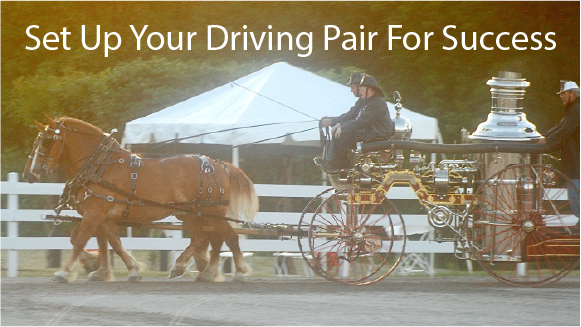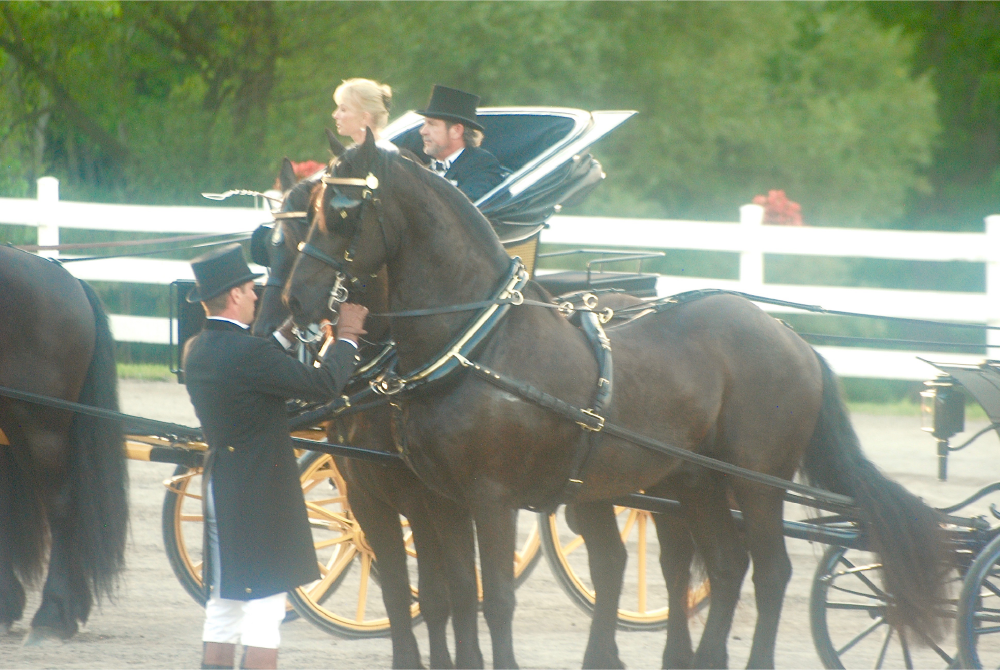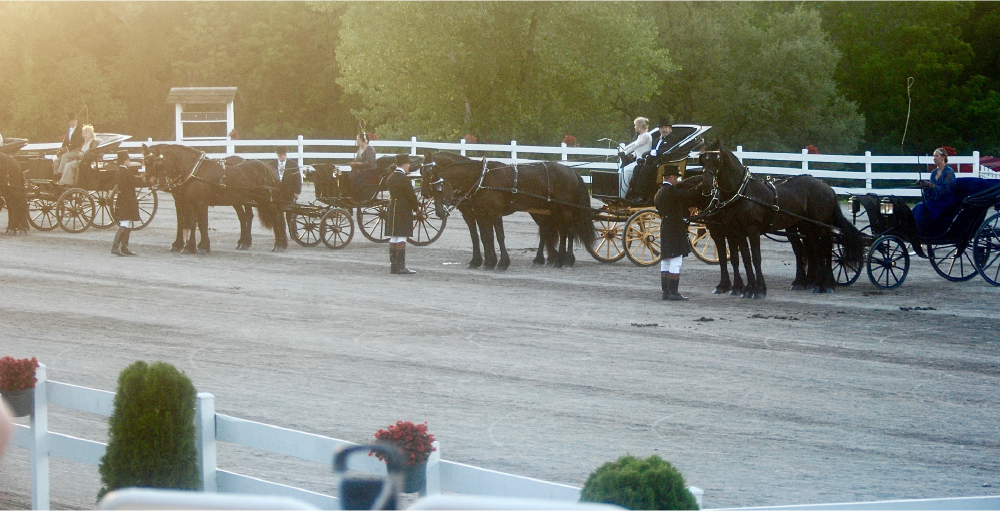Set Up Your Driving Pair For Success
By Nikki Alvin-Smith

Once the skill of driving a single horse has been accomplished many carriage driving aficionados will be ‘tempted to attempt’ pair driving. As with the single turnout the choice of horse must come before the selection of carriage.
The ‘fit, form and function’ of horse, harness and carriage must be carefully decided if the adventure is to be successfully executed without undue stress on the horses, or unexpected and unwelcome experiences for the neophyte pairs driver seated behind the splinter board.
Second Horse Must Not Be Second Rate
Unless you are blessed to be a breeder with a collection of similar genetic equine stock at hand, that will likely offer a ‘phenotypical’ partner for your already trained and talented driving horse, the quest for a second horse will be an arduous undertaking and not one for the faint of heart.
As with any purchase there are a litany of ‘needs versus wants’ that will need to be married in the search process. Knowledge of these few basic rules will set you on the right track.
For example needs should include:
· Similar size horses will pair best together. Try to match length, breadth and height of the horses.
· Gaits, agility and speed may not be identical on both horses, but they should be proportional and resemble each other sufficiently that the pair can sync easily when moving.
· The horses’ temperaments should be compatible.
· Type match heavier horses with heavier horses and lighter horses with lighter horses.
While wants might include:
· Width of quarters and shoulders of both horses are the same.
· Horses are a splitting image of each other in color and markings.
· When the team moves together one horse appears to move as a mirror image of the other in terms of gait expression and agility level. The pair of horses exhibit an apparent identical length of stride and innate ability to easily match cadence and rhythm in all gaits.
Adding To The Carriage Collection
The addition to the carriage collection will require a thoughtful approach that will depend on the ambitions of the driver. If participation in competition and showing is anticipated the type of carriage should fit the discipline.
Pair driving is most commonly executed using a four-wheeled carriage such as a Dog Cart of Phaeton. Custom built four-wheelers, wagon style vehicles and a myriad of carriage types can be utilized for special needs such as eventing and rallies.
Due diligence should be paid to fit as well as form and function of the carriage, with due consideration of suspension, wheel types, shaft lengths and heights, and all the same components that were hopefully correctly fitted by the driver for use in their current single turnout vehicle.
It is prudent to also consider the size and style of the carriage as it pertains maintenance needs, and to storage when not in use and transportation requirements if travel to competition is planned.

Harnesses, Hang-Ups ~ Learn The Lay On The Land
No driver wants to be holding the reins when a hang-up occurs on a piece of tack and equipment fitted to the horse. Incorrectly directed snaps can catch on other parts of equipment either before, during or after horses are put to the carriage. Remember that wherever possible, the use of buckles rather than snaps in bridles and harness equipment is a good safety design measure, as buckles are much less likely to hang-up on vehicle parts or tack or become undone during use and generally allow for more adjustment.
While the additional tackle required for putting a pair versus a single set-up does require a high level of conscientious attention, it is something that can be easily mastered with some forward planning and understanding.
One of the simplest methods to learn the sequence of steps required to put together horses to harness is to use the ‘lay of the land’ and set the equipment out on the ground before attempting to ‘put it’ on the critters.
The fit of harnesses is a complex topic and material for a whole other in-depth article so won’t be detailed here. But there are a few take home points that every driver should keep foremost in their minds viz:
· If a mistake is noted when putting the pair to the carriage, it is wise to immediately remove the horses from the vehicle to make the necessary adjustments rather than try to remedy the mistake while the animals are attached. It is extremely dangerous to squeeze between the horses to try and fix an error in tacking up.
· Safety protocols should be followed at all times to protect both horse and human from injury. Just as you wouldn’t dream of holding a horse tight by the ring or shank of its bit because you couldn’t reach an elusive bridle cheekpiece buckle, don’t be tempted to fix issues that are out of easy reach when a pair of horses are standing side by side. And don’t be lulled into a false sense of security because you believe the horses are quiet and obedient. For example, however well trained the pair of horses are considered to stand quietly, never let go of the reins even for a moment.
· The correct fit of bit, bridles and harnesses first to the individual horse, and then to both horses as they work in conjunction with each other ( especially the coupling rein adjustment) is essential for a successful partnership in terms of workload. A common misconception is that one horse in a pair may be lazy, not pulling his weight, when in fact it is the case that the harness is incorrectly adjusted. Of course some horses just like us humans, are more willing or keen to work than others, but setting your pair of equines for success includes making astute adjustments to how they are ‘fit’ into their own harness and how they are married to each other and the carriage.
Training The Pair ~ Safety In Numbers
In the equestrian world the notion of pairing a green horse with a green rider is considered a recipe for a disaster unless expert tuition and assistance is available to the partnership. Similarly in the world of driving, the idea of pairing a green driving horse with an inexperienced driving partner is to be avoided.
It is not essential that both horses share a similar level of experience training wise. A driving horse that has proven himself obedient and understands his job well can be a leader in the partnership when the second horse is behind on the learning curve.
However, it should not be assumed that the critter that is keenly plowing forward in the harness is the leader of the pair. In fact, it is often the more stoic natured horse that is literally behind the curve on corners, and that settles to its task without fuss that is the leader in the relationship and that keeps the less educated horse calm in the variant situations that may be encountered when the pair are working alongside in their own traces.
As the two horses should work equally in those four traces, the driver must allow for one horse to work with a longer stride when on the outside of a curve or corner, and its counterpart to contract or collect its stride to allow for the correct tension on the traces and reins, and accommodate the turn of the vehicle.
It is thus essential that both partners in the driving pair have a clear understanding of the half-halt and the ability to collect and lengthen their strides on command of the true leader of the team, the driver!
Obviously, a horse that has little or limited understanding of the driver’s commands and lacks compliance to those requests in a single turnout will not magically improve with the addition of an equine colleague. It is essential that both horses have a clear fortitude for the demands of carriage driving, both mentally and physically, before being put together.
Having said that, horses do learn much from each other. As an advanced dressage rider, I often ride a young horse who is learning the baby step versions of piaffe in the company of one of our Grand Prix trained horses who is being ridden in the same arena, who can exhibit the movement casually within view of the apprentice. We all need inspiration to excel.
Similarly, an educated, kind, calm and collected driving horse, can settle a more nervous type of equine character, and build the less trained individual’s confidence through its good example. Let us hope that the influence does not appear the other way about during training, or changes must be quickly made to the partnership with more training ‘apart’ and quickly addressed for safety’s sake.
Part of the training process should always include switching the sides on which each horse works to accustom both horses to the differences between working on the left and right of both the carriage and being placed closer to oncoming traffic, pedestrians, mailboxes and obstacles that may be encountered during an outing.
It is also a good idea to work the horses in single turnout periodically, to prevent them from becoming herd bound to the partner and to establish and maintain clear lines of communication and expectations between horse and driver.

Take Home Message
As with any new endeavor, forward planning, and a clear understanding of how to accomplish the task at hand is the key to a successful outcome. Horses, thankfully, are not machines.
As a trainer, the diversity and individualism of horses across all breeds and types are to be embraced. Every horse, whatever discipline its human owner has chosen for its education, deserves the opportunity to reach its full potential and to shine. In fact, the word ‘train,’ actually comes from the Latin word ‘trahere’ meaning to ‘pull/draw out,’ and that assuredly bringing out the best in our horses is our job when we bring them into our yard.
None of us know what we do not know, so never be shy to seek expert guidance as you set forth and tackle new challenges. This is truly the best way to ensure a positive result and can potentially avoid much heartache. Pair driving truly can be double the fun of the single turnout, and who knows what multiples of driving horses will come afterward.
Happy Driving!
About the author: Nikki Alvin-Smith is a professional writer and content creator, who works with a variety of publications and manufacturers worldwide. She is a British international Grand Prix dressage trainer/clinician who has competed in Europe at the Grand Prix level earning scores of over 72%. Together with her husband Paul, who is also a Grand Prix rider, they operate Willowview Hill Farm, a private horse breeding/training farm in Stamford, NY. Please visit her website at https:/www.nikkialvinsmithstudio.com to learn more.


